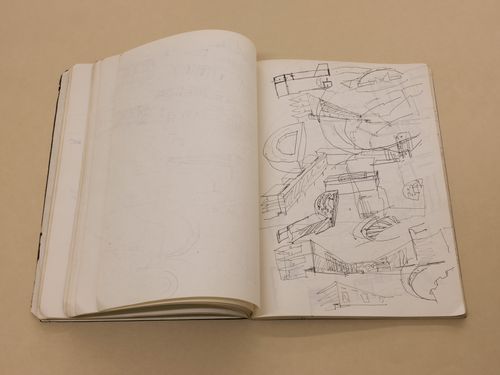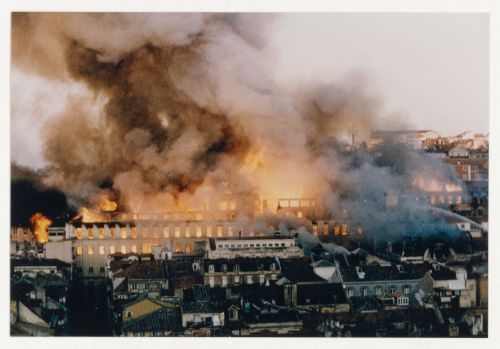photographies
AP178.S1.1984.PR02.017
Description:
Original file title: Porto- Haia. Note that a groupe photograph in The Hague includes signatures on the back. Siza's office numbered photographic materials in this file PH 001-009.
circa 1981-1984
Photographs of Adri Duivesteijn's trip to Porto and Álvaro Siza's trip to The Hague, Punt en Komma
Actions:
AP178.S1.1984.PR02.017
Description:
Original file title: Porto- Haia. Note that a groupe photograph in The Hague includes signatures on the back. Siza's office numbered photographic materials in this file PH 001-009.
photographies
circa 1981-1984
PH2019:0007:012
Description:
The number of the object depicted is AP178.S2.1986.017
October 2018
The Museum Is Not Enough: Photograph of Alvaro Siza's sketches for the Faculty of Architecture of the University of Porto, October 1986
Actions:
PH2019:0007:012
Description:
The number of the object depicted is AP178.S2.1986.017
photographies
AP178.S1.2003.PR02.046.1
Description:
Original file title: Palazzo Donaregina Napoli fotos 2 visitas
2004-2005
Photographs from Siza's visits, Recupero del Palazzo Donnaregina / Museu de Arte Contemporâneo, Naples (folder 1 of 3)
Actions:
AP178.S1.2003.PR02.046.1
Description:
Original file title: Palazzo Donaregina Napoli fotos 2 visitas
photographies
2004-2005
dessins
AP178.S1.2003.PR02.046.2
Description:
Original file title: Palazzo Donaregina Napoli fotos 2 visitas
2004-2005
Photographs from Siza's visits, Recupero del Palazzo Donnaregina / Museu de Arte Contemporâneo, Naples (folder 2 of 3)
Actions:
AP178.S1.2003.PR02.046.2
Description:
Original file title: Palazzo Donaregina Napoli fotos 2 visitas
dessins
2004-2005
dessins
AP178.S1.2003.PR02.046.3
Description:
Original file title: Palazzo Donaregina Napoli fotos 2 visitas
2004-2005
Photographs from Siza's visits, Recupero del Palazzo Donnaregina / Museu de Arte Contemporâneo, Naples (folder 3 of 3)
Actions:
AP178.S1.2003.PR02.046.3
Description:
Original file title: Palazzo Donaregina Napoli fotos 2 visitas
dessins
2004-2005
photographies
Quantité:
50 photographie(s)
PH2016:0100:001-050
Description:
50 prints by Giovanni Chiaramonte showing Álvaro Siza’s social housing project Quinta da Malagueira (Malagueira Residential District), Évora, Portugal, during construction and after completion. The photographs of the construction site during were taken in 1985 and the photographs of the project completed in 1996. The photographs were printed in 2016.
1985 and 1996
Group of photographs showing Álvaro Siza’s Quinta da Malagueira (Malagueira Residential District), Évora, Portugal, during construction and after completion
Actions:
PH2016:0100:001-050
Description:
50 prints by Giovanni Chiaramonte showing Álvaro Siza’s social housing project Quinta da Malagueira (Malagueira Residential District), Évora, Portugal, during construction and after completion. The photographs of the construction site during were taken in 1985 and the photographs of the project completed in 1996. The photographs were printed in 2016.
photographies
Quantité:
50 photographie(s)
1985 and 1996
ARCH281986
1988
documents textuels, photographies
AP178.S1.1983.PR08.010.1
Description:
Original file title: Macau diversos asuntos This file includes an article of the Open House International (Vol. 9., no 4., 1984).
1981-1990
General documentation, photographs of Siza's visit, and preliminary building program for the Zona Da Baia Da Praia Grande, Plano de Expansão da Cidade de Macau (Areia P. e Porto E.), Macau (folder 1 of 2)
Actions:
AP178.S1.1983.PR08.010.1
Description:
Original file title: Macau diversos asuntos This file includes an article of the Open House International (Vol. 9., no 4., 1984).
documents textuels, photographies
1981-1990
documents textuels
AP178.S1.1983.PR08.010.2
Description:
Original file title: Macau diversos asuntos
1981-1990
General documentation, photographs of siza's visit, and preliminary building program for the Zona Da Baia Da Praia Grande, Plano de Expansão da Cidade de Macau (Areia P. e Porto E.), Macau (folder 2 of 2)
Actions:
AP178.S1.1983.PR08.010.2
Description:
Original file title: Macau diversos asuntos
documents textuels
1981-1990
Projet
AP178.S1.1958.PR01
Description:
This project series documents the Casa de Chá, Restaurante da Boa Nova in Leça de Palmeira, Portugal. While the records were held in the office’s archives this project was assigned the number 9/50. In the past the office identified the project as number 99. The office assigned the dates 1958-1963 for this project. The coastal site for this project was selected by Portuguese architect Fernando Távora. The project was built after the proposal won an architecture competition held by the municipality of Matosinhos in 1958. Távora initiated the project in collaboration with Francisco Figueiredo, and later handed the project over to Siza. In an interview with Eduardo Souto Moura, Moura recounts that Távora gave the project to Siza and five other aids before leaving on vacation (Juan Rodrigues, Carlos Seoane, et al, “Siza by Siza”). In the 1970s, Siza designed the furniture for this project and also worked on the 1990s restoration and renovation work. The project series consists of sketches, studies, plans, elevations, and details for the Casa de Chá, Restaurante da Boa Nova as well as sketches of the furniture designed by Siza. Photographs, negatives, and slides document the exterior and interior of the built project, as well as the project site. There are also postcards of the built project and photographs taken by photographers Rui Morais de Sousa, Juan Rodriguez, Alvão (Azevedo & Fernandes), Stitchting Wonen, and Charters. Textual documentation includes correspondence from the Câmara Municipal de Matosinhos, including correspondence addressed to Távora, as well as correspondence from Távora and Siza. Also included are notes and project documentation.
1959-1999
Casa de Chá, Restaurante da Boa Nova [Tea house, Boa Nova restaurant], Leça da Palmeira, Portugal (1958, 1959-1963)
Actions:
AP178.S1.1958.PR01
Description:
This project series documents the Casa de Chá, Restaurante da Boa Nova in Leça de Palmeira, Portugal. While the records were held in the office’s archives this project was assigned the number 9/50. In the past the office identified the project as number 99. The office assigned the dates 1958-1963 for this project. The coastal site for this project was selected by Portuguese architect Fernando Távora. The project was built after the proposal won an architecture competition held by the municipality of Matosinhos in 1958. Távora initiated the project in collaboration with Francisco Figueiredo, and later handed the project over to Siza. In an interview with Eduardo Souto Moura, Moura recounts that Távora gave the project to Siza and five other aids before leaving on vacation (Juan Rodrigues, Carlos Seoane, et al, “Siza by Siza”). In the 1970s, Siza designed the furniture for this project and also worked on the 1990s restoration and renovation work. The project series consists of sketches, studies, plans, elevations, and details for the Casa de Chá, Restaurante da Boa Nova as well as sketches of the furniture designed by Siza. Photographs, negatives, and slides document the exterior and interior of the built project, as well as the project site. There are also postcards of the built project and photographs taken by photographers Rui Morais de Sousa, Juan Rodriguez, Alvão (Azevedo & Fernandes), Stitchting Wonen, and Charters. Textual documentation includes correspondence from the Câmara Municipal de Matosinhos, including correspondence addressed to Távora, as well as correspondence from Távora and Siza. Also included are notes and project documentation.
Project
1959-1999

